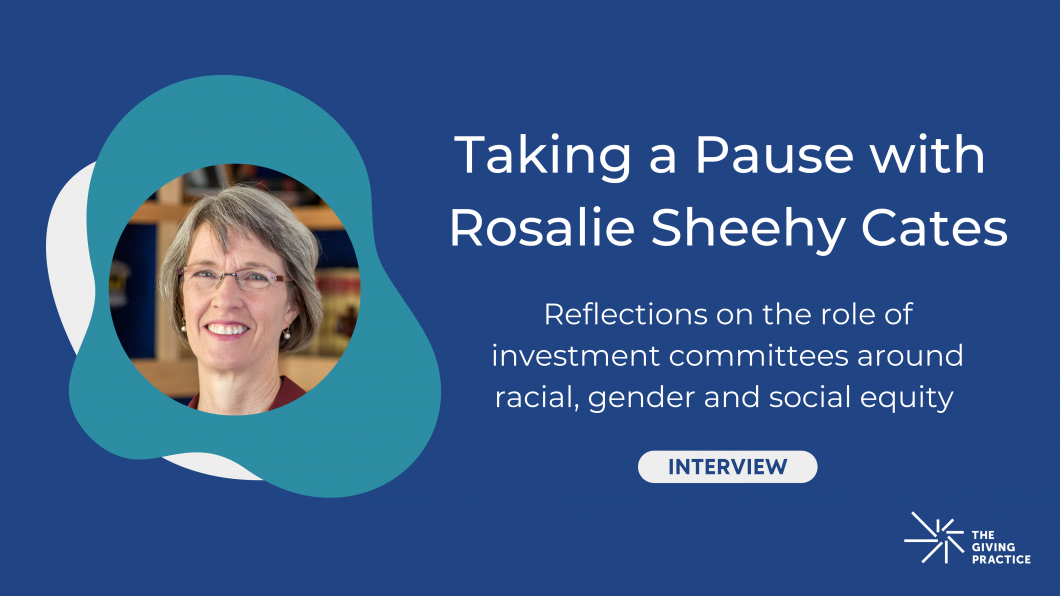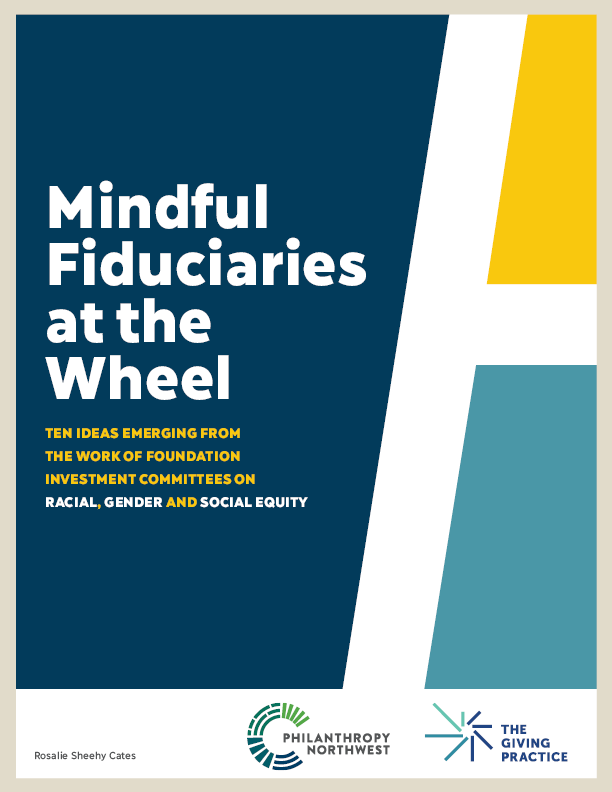
Equity. To understand and achieve it in our communities is the work of a lifetime. We’re inspired every day by our clients, partners, neighbors and friends who have embarked on equity-focused journeys — and today we are excited to share our insights and observations on foundation investment committees’ journeys around racial, social and gender equity.
We capture these observations in Mindful Fiduciaries at the Wheel, a report produced in partnership with our colleagues at Philanthropy Northwest based on research and analysis by Senior Advisor, Rosalie Sheehy Cates. In it we summarize ten big ideas that bubbled up from extensive interviews with foundation trustees, CIOs, investing staff, outside investing advisors and industry advocates.
“It felt like I was almost witnessing a quiet, practical revolution at the investment committee level,” Rosalie reflects.
“Investment committees all over the country are in the midst of very careful work to incorporate the fundamental concepts of racial, social and gender equity,” she continues. “It can be quite a shift in their sense of duty, quite a sober look at the power you have as an asset manager. And, they address practical investing dilemmas at the portfolio level.”
At Philanthropy Northwest and The Giving Practice, we wanted to convey a realistic sense of the work for this unique group of fiduciaries. We especially wanted to highlight the good thinking that is already occurring as it's paving the way for more foundation asset owners to take up equity issues.
More on Rosalie’s perspective on the report:
Q: What do you hope that readers will take away from the report?
First, I hope they really feel the respect and delight I feel for the investment committee function. It’s such a unique role! I can’t get over the hopefulness of a sector that puts volunteers in charge of billions of dollars of assets. And it works. But it’s hard now — we’re asking those committees to go into some uncharted waters for investment people.
I also hope we cut to the chase at a practical, governance level for investment committees. This report is not an investing guide — it’s a governance guide.
The first main issue is for leaders to see that there are different ways of viewing fiduciary duty. That it’s possible to be within your duty to take a strict approach to risk and pay attention to racial, social and gender equity. Many foundations are doing this. They are laying the groundwork that clarifies this new version of fiduciary duty for foundation trustees.
Another big thing is that we have to be overt about the issue of power. Being an asset owner is simply a very powerful thing. Being on an investment committee gives that power to you. It’s one of those things we are not comfortable talking about. We know about all the good we can do with foundation power, but it is less comfortable squaring up with our potential to do harm. People talked about that issue with us and I think it is fundamentally important.
Q: What impact do you hope this report will create both in the short and long-term?
Q: Why haven’t fiduciary leaders been able to pause as much?
As we say in the report, investment committees already have a job. Their portfolios don’t go on hold while they mindfully reconsider the investing thesis. And, just culturally, pausing is hard. Foundations have been traditionally breakneck, overworked. This work is pretty heartful which is hard to fit in.
Q: What inspired you to produce this report?
We wanted to highlight the particular work of investment committees in regard to racial, social and gender equity, and we wanted to do that from a respectful and enthusiastically supportive stance. This continues the conversation from our 2019 report, Forging Ahead, about DEI investing at foundations.
I actually love financial work, and I think financial people get a bum rap for not being “creative.” Just think how creative mortgage derivatives are — they brought the whole economy down! But I see the good side of that creativity in the work of business lenders, social investors or just from accountants who keep the money wheels turning for everybody else. Our tools are so powerful, especially when you are an asset owner. I just want to spread the creativity and the potential for good.
Q: What were some of the biggest aha moments that you experienced while working on this report?
I've been in this business for a long time, and I’ve never seen anything like the visceral commitment of those working to fix racial equity in their investing. I think the human cost of racial equity issues just hits us in the gut. It opens us to a very fundamental re-thinking of our investing attitudes and practices. And I also want to note that women and people of color in particular are playing a significant role in leading these changes.
Q: What’s next? How do we bring mindfulness to life in practice?
Well, we have been working with investment committees, especially in tandem with their advisors. We helped one committee design their annual workflow, so everybody had a clear sense of all the practical quarterly, semi-annual and annual investment oversight jobs. We asked the advisor to boil down the detailed Investment Policy Statement into 10 commandments for their endowment management. But we also made room for learning and created an annual flow for the committee’s learning and reflection — this is where they keep asking about racial, social and gender equity, and keep evaluating their work on that. I think the advisor was really pleased with the ownership and engagement that this investment committee showed.
There are also a lot of specific questions and discussions that committees can have, and they walk a tricky kind of balance beam. The group needs good psychological safety to work well together — after all they are responsible for complex and ambitious investment goals. But learning occurs on the edges of where you feel safe, and innovation tends to push those edges out. This is really evident when committees take on racial, social and gender equity. So that is our challenge: providing investment committees and their advisors with a solid balance beam, and spotting people as they walk across it.
We want to thank everyone who participated in the making of the report and the Northwest Area Foundation for supporting us with the resources necessary to bring it to life.
You can download and read the report here to learn more about diversity, equity and inclusion in foundation investing activities — with additional insights available in our report, Forging Ahead. And if you raised an eyebrow at any time throughout this piece — if you’re curious about how you and your investment committee can evolve to meet these critical needs in our communities, we would love to hear from you.
Join our email list to receive updates on our latest reflections, insights, interviews and more.






